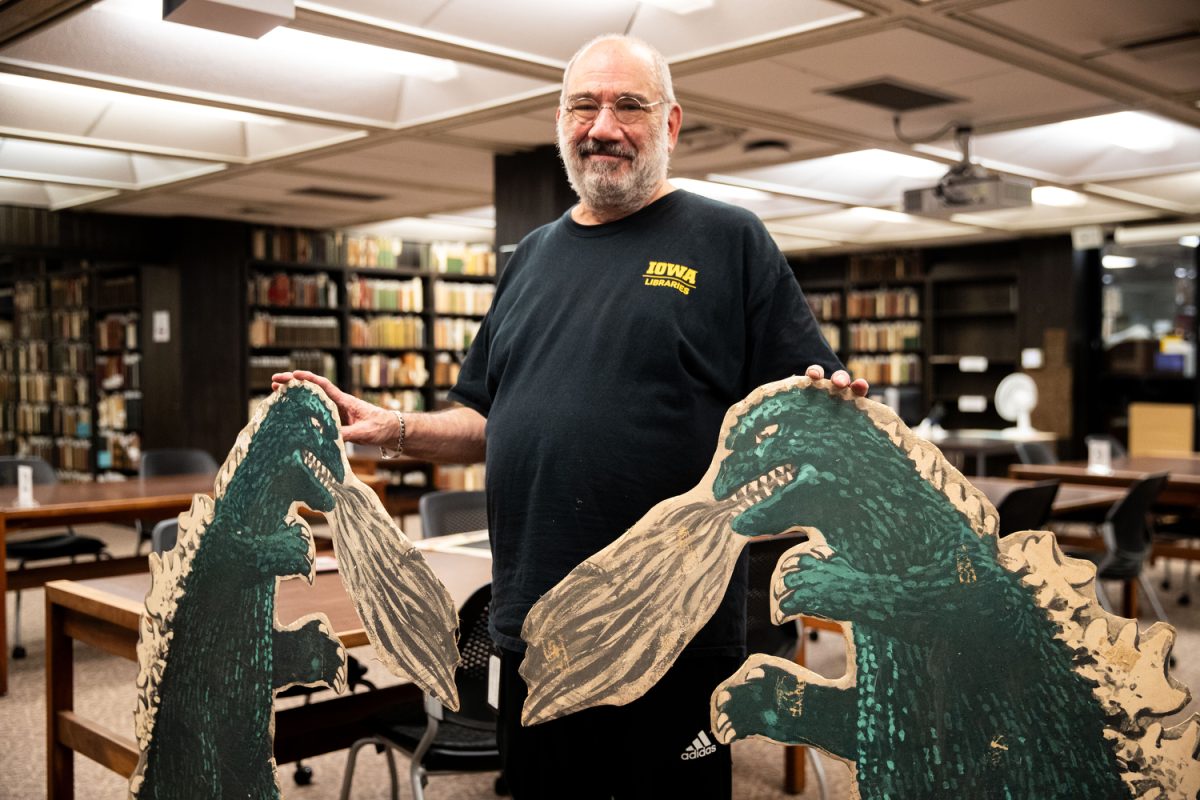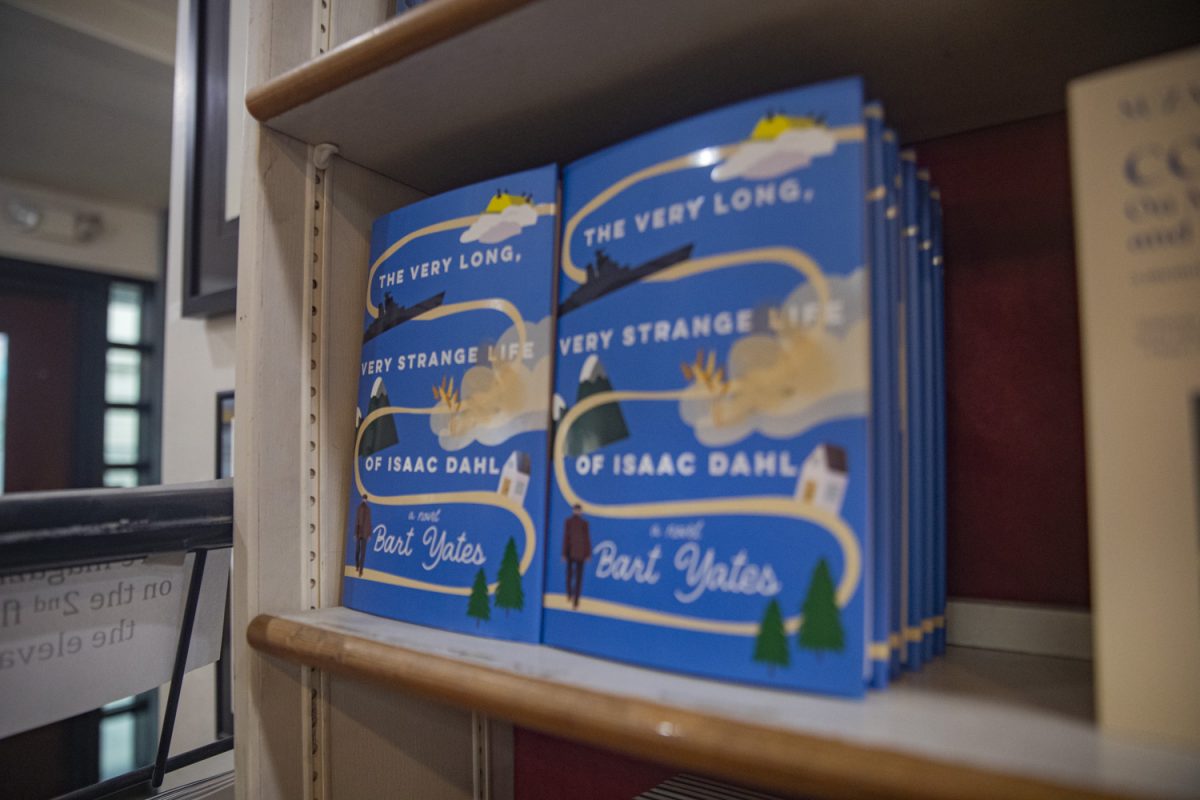Since the first presentation of a motion picture in December 1895, film has played a large role in society. High-budget cult-classic movies like “Star Wars,” “The Godfather,” and “Harry Potter” have all sparked massive cultural fervor.
Detached from mainstream cinema, however, is the often-forgotten world of budget film. Largely popular during the Golden Age of Hollywood, “b-films” were heavily genre-specific, typically falling under the categories of horror, western, or science-fiction. In large part, the creation of b-films faded due to the transformation of the studio system, which began to produce bigger movies formerly reserved for low-budget production.
However, the concept didn’t go entirely dark — even in Iowa City.
Low-budget, under-the-radar films still reach audiences today with the help of people like local cinephiles Ross Meyer, Aaron Holmgren, and Joe Derderian.
Meyer, Holmgren, and Derderian curate FilmScene’s “Late Shift at the Grindhouse” series, a program dedicated to screening low-budget, zany flicks every Wednesday night at 10 p.m.
Typically sporting run times of under 70 minutes, b-films are often produced in remarkably short amounts of time. The rising popularity of the double feature required production companies to construct quick, low-cost complements to their high-budget counterparts.
Pete Balistrieri, the curator of science fiction and popular culture at the University of Iowa’s Special Collections and Archives, is highly familiar with b-films and their historical significance.
“B-movies like to copy each other, but with b-movies, it doesn’t matter whether they’re copying something successful or not,” Balistrieri said. “When I’m talking to people about the [budget] science-fiction movies, I always say sooner or later, you’ll see flashing lights because it’s a science-fiction movie. If it’s got any flashing lights, then of course it’s science fiction.”
Certain characteristics from b-films have carried over into modern film, including the flashing lights found even in new science fiction films, Balistrieri said.
Historically, b-films simply did not have the budget to utilize a full set. Therefore, shooting was often done on location. In the 1960s, they looked like any typical movie; today, they offer an authentic glimpse into the past.
RELATED: ‘FilmScene in the Park’ brings community together to experience cinema
“I love these Japanese science fiction films from the mid-50s to the late-60s,” Balistrieri said. “There are so many of them that have these beautiful little glimpses into Japanese life at the time. The inside of a very modest Japanese home. The inside of restaurants. Things you don’t see in other films.”
Running since 2014, the “Late Shift” series often features the original filmmakers, and, occasionally, performers, who watch the film with the audience and answer questions afterward.
“It’s Kung Fu movies, it’s horror movies, sometimes it’s really raunchy eighties comedies,” Meyer said. “It’s kind of all over the map.”
Films can range from moderately popular thrillers, like “I Know Who Killed Me” starring Lindsay Lohan, screened last Wednesday, to largely unknown films, like “Hell Van.”
Unlike mainstream cinema, gaining access to underground films can prove highly difficult.
“There’s some instances where Ross has to track down who has the distribution rights to these films,” Holmgren said. “And sometimes, that’s the deal breaker.”
Holmgren mentioned that on certain occasions, they are unable to pinpoint who exactly the rights belong to. In other instances, the filmmaker may charge a high royalty to screen the film.
Underground filmmakers often have far more room to deviate from mainstream cinematic norms, offering a unique viewing experience for audiences.
“I love the idea of these gritty movies,” Meyer said. “And I especially love the idea of watching these gritty movies with a crowd of people.”
The series’ title “Late Shift at the Grindhouse” is a callback to a type of movie theater that was popular from the 1930s until the 1980s. Also known as “action houses,” these theaters were devoted to screening “gritty” action, horror, and exploitation b-films.
Exploitation films serve the purpose of “exploiting” trends and niche concepts, typically containing destruction, chaos, sex, gore, or other taboo themes.
Meyer said theaters usually became grindhouses because of funding problems, aiming to draw audiences back in to see something they had never encountered before.
“These exploitation b-movies were a way to breathe life into theaters that were losing money and turn them back into profitable theaters,” Meyer said. “I think there’s something exciting about that.”
After the advent of home video and the domination of the VHS in the 1980s, grindhouse theaters mostly fizzled out into extinction.
Still, FilmScene’s grindhouse series draws denser crowds than originally anticipated. Derderian shared that despite the belief that b-films are incredibly niche, their audiences have been quite large and seem to immensely enjoy the films.
Derderian said screening older b-films fosters more appreciation for the films than there was for their original release, citing John Carpenter’s remake of “The Thing” as an example.
When the movie premiered in 1982, it was an immediate flop. Viewers generally disliked the elements of horror and gore Carpenter integrated into the film, while the original 1951 film had been strictly science fiction. The fallout nearly cost Carpenter his career.
Today, the 1982 version of “The Thing” is considered a cult classic. The passing of time has allowed viewers to revisit the film and recognize Carpenter’s craftsmanship and the way he connected complex themes in one tense, atmospheric film not for the faint of heart.
As part of the Grindhouse series, FilmScene will screen a restoration of the 1995 comedy-drama film “Teenage Tupelo” on Oct. 25, featuring director Mike McCarthy. McCarthy’s most popular movie, “The Sore Losers,” has only been logged 252 times on IMDb — a miniscule amount compared to the recent blockbuster “Barbie,” logged 323,000 times.
Regardless, McCarthy is one of Meyer’s favorite directors.
Meyer said it is exciting to bring in very unknown filmmakers and present them with the same prestige as someone more known, like Werner Herzog, who will visit the Englert Theatre on Oct. 15 for Iowa City’s second-ever Refocus Film Festival this fall.
“I think there’s something exciting about playing a movie that we might be one of only three or four movie theaters that are actually going to play it,” Meyer said.
For under-the-radar filmmakers, seeing their movie on the big screen is never a guarantee.
“I think it’s a valid art form that deserves to be presented with the highest level of care and presentation to show value in these films that don’t always get the value they deserve,” Meyer said.
Over the years, the definition of a ‘b-film’ has changed. At one point, it was simply the back end of a double feature. People would head over to the drive-in to see a blockbuster “a-film,” and the “b-film” would follow as a filler.
Today, a b-film can mean a variety of different things, from a virtually unknown horror flick to an independent cult classic.
“Think about b-movies as the minor leagues,” Balistrieri said. “You’re a big studio. You’ve got a major team in the major leagues. You’ve got a minor team in the minor leagues … Here’s where you try out managers, coaches, everything. If it fails, it’s okay. Because there’s a guaranteed audience for the minor leagues.”












